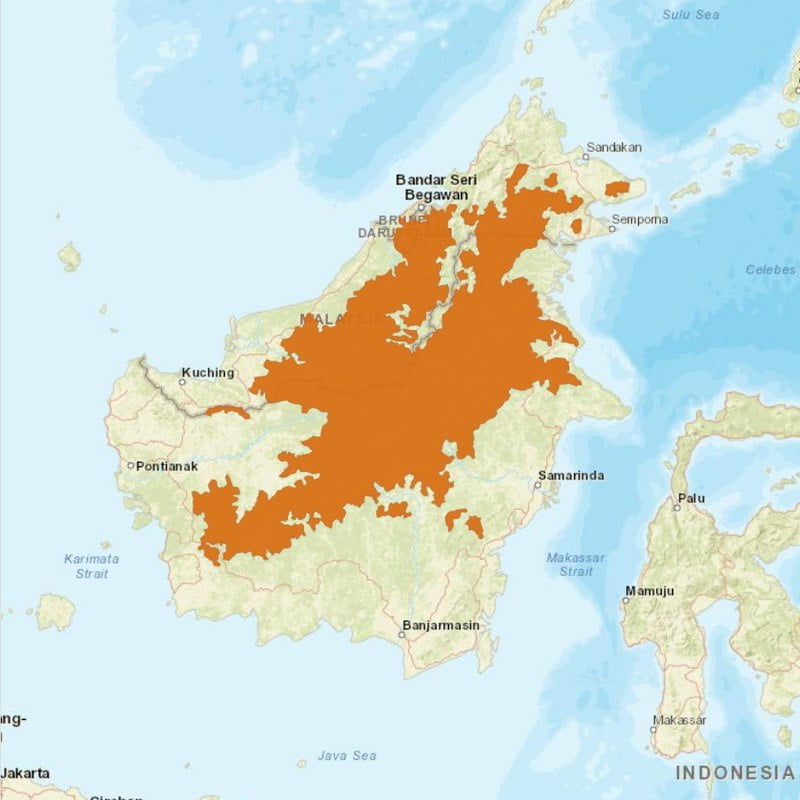There is a photograph of the bay cat I can’t get out of my head. In it, the cat looks intensely right at the viewer, its sun-yellow eyes sporting two dark lines running up from them as if someone had applied makeup. In the mix of light and shade, its coat passes from brown to orange to blood red. Its long tail is tipped in white. The animal is in a dingy cage, littered with dead rats, but that doesn’t detract a bit from the cat’s majesty and strangeness.
Jim Sanderson, the world’s leading expert on small wildcats, took the photo in 2008. The cat, which had previously been kept in a cage in a gas station, was being held in a private menagerie in Sarawak, Malaysian Borneo.
Sanderson, who founded the Small Wild Cat Conservation Foundation, says the cat’s owner “knew what he had.” And what he had was arguably the world’s most elusive wildcat — and among the most endangered. A few days later, the cat was gone — likely sold for a pile of cash into the illegal wildlife trade. Its end was probably ignominious.
The Borneo bay cat (Catopuma badia) is so rare, elusive and strange that after its discovery, it vanished from science for more than 60 years. Today, the bay cat remains stubbornly difficult to even find, no less research or conserve. It makes the snow leopard look conspicuous.
What we know, and what we don’t
“The bay cat is a black hole, and we don’t even know how to start to study the species, it is so elusive,” says Oliver Wearn, a biologist and conservation consultant. “They are about as elusive as any mammal can be.”
There are a few things we do know. C. badia is the only feline endemic to Borneo, and its appearance is distinctive, making it easy to tell apart from the other four cat species living there due to its “bay” (reddish-brown) coloring — though there are other color variants — and due to its super-long tail.
Sebastian Kennerknecht, photographer and founder of Cat Expeditions, a global cat tourism group, notes that the bay cat “kind of looks like a mini puma but isn’t even in the same genus.” The animal is most closely related to the Asian golden cat (Catopuma temminckii), but these two felines likely evolved down different paths more than 3 million years ago.

Oh, and we know it lives in the forest.
And that’s about it. We don’t know any behavior basics: the ecological niche it fills, what kind of forest it prefers, what it eats, whether it’s an arboreal cat or ground hunter, how much territory it needs or how the species mates and rears young.
The biggest mystery, and the one holding up conservation efforts: Why is this cat so frustratingly rare?
To date, Sanderson’s 2008 photos of that male feline remain some of the best in the world. And one day, if the worst happens, that photo may be one of few records of a never-known feline.
‘It does exist’
Despite years doing field research, biologist Susan Cheyne has never seen a bay cat. There’s even “some speculation that it doesn’t exist,” she says. Cheyne is the co-founder and director of research at Borneo Nature Foundation International (BNF), which works in Kalimantan, Indonesian Borneo.
Kennerknecht, who’s led tours in Borneo, has seen all of the island’s elusive cat species in the wild — except the bay cat. “Even most of the super-serious cat chasers out there have not yet seen this species,” he says.
When I ask Cheyne if she knew anyone who’d ever seen it in the wild, she says, “No,” but then adds emphatically, “It does exist.”
Alfred Russel Wallace, famed biologist and the second father of evolution, was the first scientist to come across the bay cat, sending a skin and skull back to the U.K. in 1856. Scientists collected five more specimens over the next few decades, but after 1928, the bay cat vanished.
“There have been a few rumors of the cat’s continued existence, some unsuccessful searches, and the occasional unconfirmed sighting,” reads a 1993 paper in Oryx.
That changed on Nov. 4, 1992, when a nearly dead female bay cat was brought to the Natural History Museum in Sarawak. Indigenous people had trapped and kept the cat for several months.
“The specimen was about the size of a domestic cat with an extremely long tail. It weighed 1.95 kg [4.29 lbs], but was in a thoroughly emaciated condition with wasted muscles and protruding bones,” according to the Oryx paper, announcing the discovery.











